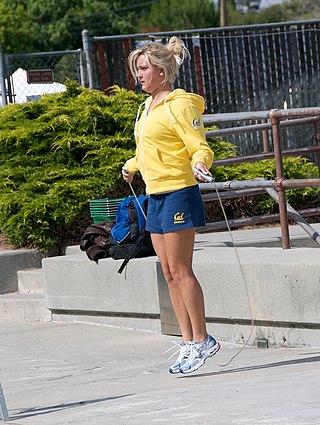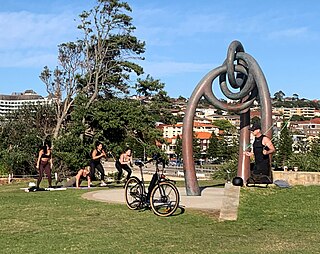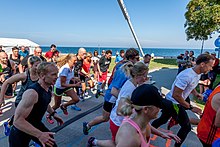
Running is a method of terrestrial locomotion by which humans and other animals move rapidly on foot. Running is a gait with an aerial phase in which all feet are above the ground. This is in contrast to walking, where one foot is always in contact with the ground, the legs are kept mostly straight, and the center of gravity vaults over the stance leg or legs in an inverted pendulum fashion. A feature of a running body from the viewpoint of spring-mass mechanics is that changes in kinetic and potential energy within a stride co-occur, with energy storage accomplished by springy tendons and passive muscle elasticity. The term "running" can refer to a variety of speeds ranging from jogging to sprinting.
James Fuller Fixx was an American who wrote the 1977 best-selling book The Complete Book of Running. He is credited with helping start America's fitness revolution by popularizing the sport of running and demonstrating the health benefits of regular jogging. He died of a heart attack while jogging at 52 years of age; his genetic predisposition for heart problems and other previous lifestyle factors may have caused his heart attack.

Exercise is intentional physical activity to enhance or maintain fitness and overall health.

Aerobic exercise is physical exercise of low to high intensity that depends primarily on the aerobic energy-generating process. "Aerobic" is defined as "relating to, involving, or requiring oxygen", and refers to the use of oxygen to meet energy demands during exercise via aerobic metabolism adequately. Aerobic exercise is performed by repeating sequences of light-to-moderate intensity activities for extended periods of time. Examples of cardiovascular or aerobic exercise are medium- to long-distance running or jogging, swimming, cycling, stair climbing and walking.

Physical fitness is a state of health and well-being and, more specifically, the ability to perform aspects of sports, occupations, and daily activities. Physical fitness is generally achieved through proper nutrition, moderate-vigorous physical exercise, and sufficient rest along with a formal recovery plan.

Cardiovascular disease (CVD) is any disease involving the heart or blood vessels. CVDs constitute a class of diseases that includes: coronary artery diseases, heart failure, hypertensive heart disease, rheumatic heart disease, cardiomyopathy, arrhythmia, congenital heart disease, valvular heart disease, carditis, aortic aneurysms, peripheral artery disease, thromboembolic disease, and venous thrombosis.

A multivitamin is a preparation intended to serve as a dietary supplement with vitamins, dietary minerals, and other nutritional elements. Such preparations are available in the form of tablets, capsules, pastilles, powders, liquids, or injectable formulations. Other than injectable formulations, which are only available and administered under medical supervision, multivitamins are recognized by the Codex Alimentarius Commission as a category of food.
V̇O2 max (also maximal oxygen consumption, maximal oxygen uptake or maximal aerobic capacity) is the maximum rate of oxygen consumption attainable during physical exertion. The name is derived from three abbreviations: "V̇" for volume (the dot over the V indicates "per unit of time" in Newton's notation), "O2" for oxygen, and "max" for maximum and usually normalized per kilogram of body mass. A similar measure is V̇O2 peak (peak oxygen consumption), which is the measurable value from a session of physical exercise, be it incremental or otherwise. It could match or underestimate the actual V̇O2 max. Confusion between the values in older and popular fitness literature is common. The capacity of the lung to exchange oxygen and carbon dioxide is constrained by the rate of blood oxygen transport to active tissue.

Arthur Leslie Lydiard was a New Zealand runner and athletics coach. He has been lauded as one of the outstanding athletics coaches of all time and is credited with popularising the sport of running and making it commonplace across the sporting world. His training methods are based on a strong endurance base and periodisation.

High-intensity interval training (HIIT) is a training protocol alternating short periods of intense or explosive anaerobic exercise with brief recovery periods until the point of exhaustion. HIIT involves exercises performed in repeated quick bursts at maximum or near maximal effort with periods of rest or low activity between bouts. The very high level of intensity, the interval duration, and number of bouts distinguish it from aerobic (cardiovascular) activity, because the body significantly recruits anaerobic energy systems. The method thereby relies on "the anaerobic energy releasing system almost maximally".
The multi-stage fitness test (MSFT), also known as the beep test, bleep test, PACERtest (progressive aerobic cardiovascular endurance run), or the 20m shuttle run test, is a running test used to estimate an athlete's aerobic capacity (VO2 max).
Aerobic conditioning is a process whereby the heart and lungs are trained to pump blood more efficiently, allowing more oxygen to be delivered to muscles and organs. The skeletal muscles also become aerobically conditioned, as regular aerobic exercise produces a shift in muscle fibres from more type II into more type I (slow-twitch/oxidative). Type I muscle fibres have far more mitochondria than type II, making type I fibres the producers of adenosine triphosphate (ATP) primarily through oxidative phosphorylation rather than anaerobic glycolysis. Some neuromuscular diseases recommend regular aerobic exercise in order for the skeletal muscles to become aerobically conditioned, providing relief of symptoms or slowing the course of the disease, for example metabolic myopathies and Duchenne muscular dystrophy.
Cardiorespiratory fitness (CRF) refers to the ability of the circulatory and respiratory systems to supply oxygen to skeletal muscles during sustained physical activity. Scientists and researchers use CRF to assess the functional capacity of the respiratory and cardiovascular systems. These functions include ventilation, perfusion, gas exchange, vasodilation, and delivery of oxygen to the body's tissues. As these body's functions are vital to an individual's health, CRF allows observers to quantify an individual's morbidity and mortality risk as a function of cardiorespiratory health.
Interval training is a type of training exercise that involves a series of high-intensity workouts interspersed with rest or break periods. The high-intensity periods are typically at or close to anaerobic exercise, while the recovery periods involve activity of lower intensity. Varying the intensity of effort exercises the heart muscle, providing a cardiovascular workout, improving aerobic capacity and permitting the person to exercise for longer and/or at more intense levels.
Ralph S. Paffenbarger, Jr. was an epidemiologist, ultramarathoner, and professor at both Stanford University School of Medicine and Harvard University School of Public Health.
Long slow distance (LSD) is a form of aerobic endurance training used in sports including running, rowing, skiing and cycling. It is also known as aerobic endurance training, base training and Zone 2 training. Physiological adaptations to LSD training include improved cardiovascular function, improved thermoregulatory function, improved mitochondrial energy production, increased oxidative capacity of skeletal muscle, and increased utilization of fat for fuel. Ernst van Aaken, a German physician and coach, is generally recognized as the founder of the LSD method of endurance training.

Cardiovascular fitness refers to a health-related component of physical fitness that is brought about by sustained physical activity. A person's ability to deliver oxygen to the working muscles is affected by many physiological parameters, including heart rate, stroke volume, cardiac output, and maximal oxygen consumption.
The running boom of the 1970s occurred in high- and middle-income countries. It was particularly pronounced in the United States and occurred in other countries including the United Kingdom and other European countries, Australia and New Zealand.
The benefits of physical activity range widely. Most types of physical activity improve health and well-being.

Exercise medicine is a branch of medicine that deals with physical fitness and the prevention and treatment of injuries and illness with exercise. In some countries, Sport and Exercise Medicine (SEM) is a recognized medical specialty. Exercise medicine is therefore an emerging physician (non-surgical) specialty, but there is also a belief that exercise is treatment of such fundamental benefit that it should be incorporated into all medical specialties. Allied health practitioners also can specialize in exercise such as exercise physiologists, physiotherapists, athletic trainers and podiatrists.













